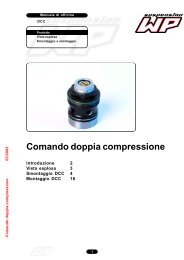Understanding ECU Remapping: The Audi TT 1.8 T - contiman - Free
Understanding ECU Remapping: The Audi TT 1.8 T - contiman - Free
Understanding ECU Remapping: The Audi TT 1.8 T - contiman - Free
Create successful ePaper yourself
Turn your PDF publications into a flip-book with our unique Google optimized e-Paper software.
<strong>Understanding</strong> <strong>ECU</strong> <strong>Remapping</strong>: <strong>The</strong> <strong>Audi</strong> <strong>TT</strong> <strong>1.8</strong>T Variants/Bosch Motronic ME7.x<br />
4.2 Why Store Information as Maps?<br />
<strong>The</strong> information required to control the engine is stored on the <strong>ECU</strong> as constants (konstanten, 1D, x),<br />
characteristic curves (kennlinier, 2D, x & y) and maps (kennfelder, 3D, x, y & z). <strong>The</strong> latter are simply look-up<br />
tables. Data is stored in look-up tables for two very good reasons. 1. <strong>The</strong>re is not necessarily a function that<br />
can return the required data because the nature of fluid dynamics is not easily predictable or linear and 2.<br />
<strong>The</strong> processor can operate much more quickly by just looking up values and interpolating between them<br />
instead of calculating each one every time a control action is required.<br />
4.3. Error Checking (Checksum Verification)<br />
Because of the harsh conditions (particularly elevated temperature and vibration levels) in which the<br />
electronics are required to operate, it is necessary to build in error checking subroutines to the <strong>ECU</strong>. For<br />
Bosch Motronic systems, this is a simple process that involves checksums. <strong>The</strong> checksum is simply the sum<br />
of all the hexadecimal data in a particular region of the code. <strong>The</strong> <strong>ECU</strong> adds up the numerical data in each<br />
area of code for which there is a checksum then compares it with the checksum. If the two values are<br />
different, it is likely that an error has occurred and the Bosch Motronic <strong>ECU</strong>s will not boot up and the engine<br />
will not run. This process is illustrated at www.motronic.ws<br />
5. <strong>The</strong> Key Maps and Parameters for Tuning<br />
5.1 Introduction<br />
This section is intended to be a fairly basic overview of which <strong>ECU</strong> parameters can be recalibrated and what<br />
changes can be made when developing a tuning strategy. It is based on the S4 wiki which I have crosschecked<br />
with information on amateur tuning internet forums to attempt to validate it. I have translated and<br />
included some information from the Bosch Motronic ME7.x funktionsrahmen (function sheet) where<br />
appropriate and have illustrated this section with actual maps from two <strong>Audi</strong> <strong>TT</strong> <strong>1.8</strong>T variant <strong>ECU</strong>s for two<br />
good reasons. Firstly, because I own a <strong>TT</strong> with highest output OEM tune (240 PS) and I have also had it<br />
remapped (which is the raison d’être for this endeavor). In addition, the <strong>Audi</strong> <strong>TT</strong> <strong>1.8</strong>T makes a good ‘case<br />
study’ because the basic engine was available with several levels of OEM tune including 180 PS, 225 PS<br />
and 240 PS and still has plenty of scope for aftermarket modification and <strong>ECU</strong> remapping. Another good<br />
Motronic ME7.x case study would be the MY2001 <strong>Audi</strong> S4 and RS4 because both have essentially the same<br />
2.7 litre twin turbo engine, but outputs greatly differ (265 PS for the AGB engine variant) and 380 PS for the<br />
ASJ engine variant) and fully-defined <strong>ECU</strong> files are available for each state of tune. A good non-VAG case<br />
study might have been any of the recent Mitsubishi Lancer Evo series 2.0T engines which are also supplied<br />
in several levels of OEM tune and have a similarly healthy aftermarket modification and <strong>ECU</strong> remapping<br />
scene.<br />
<strong>The</strong> content of this section varies greatly in scope. Some sub-sections have a fairly comprehensive technical<br />
content if there is information of general relevance in the funktionsrahmen, whereas in others, I just present<br />
the maps themselves for awareness purposes with no further discussion other than some paraphrased<br />
remarks from the S4 wiki. It is difficult to judge what and how much to include, and having to translate the<br />
prose from funktionsrahmen modules manually as a prerequisite to that judgment isn’t conducive to<br />
achieving a cogent, flowing narrative.<br />
<strong>The</strong>re does appear to be a vague consensus about what information is key to the main Motronic functions<br />
and therefore which should be considered when tuning the <strong>ECU</strong>. Table 5.1 below is a cross-comparison<br />
between the maps three amateur tuners consider to be important and the maps reported to be changed by a<br />
professional tuner. <strong>The</strong> latter column also includes differences observed between the BAM and BFV engine<br />
variants (e.g. ignition angle maps).<br />
On the FAQ section of their website, UK-based tuner Emaps state that they “…change about thirty-five<br />
different tables in a standard remap. Load, turbo boost (where applicable), ignition timing, and fuel are all<br />
adjusted as well as the variable cam timing. Some tuners change only one table while most others no more<br />
than six. By increasing one table it may be indirectly increasing another table and causing it to ‘max out’ or<br />
be at the limit of the table. This effectively leaves this table ineffective in providing necessary data for the<br />
control systems.”<br />
Tony at Nefmoto has changed the following maps in his Stage 3 tuned file for a 2001 B5 <strong>Audi</strong> S4 (<strong>ECU</strong> part<br />
number 8D0 907 551 M) and both the stock binary file and the tuned binary file are available to download on<br />
the Nefmoto forum. Apart from the modifications listed in the table, the car is running K04 turbos and the<br />
stock 3 barg FPR. Maximum boost is 22 psi.<br />
Constant, Characteristic Curve or Map Comment<br />
KRKTE (Conversion factor: relative fuel mass rk to<br />
effective injection time te)<br />
12<br />
Rescaled injection time Siemens Deka IV 630<br />
cm 3 /min injectors.



